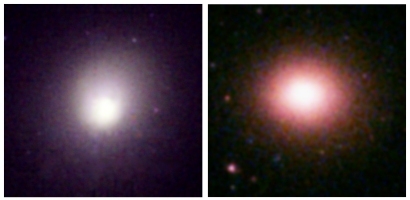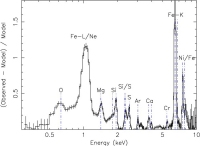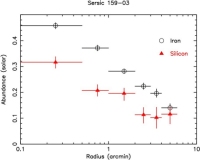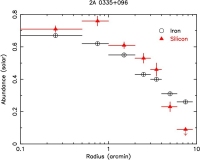XMM-Newton Reveals Origin of Elements in Galaxy Clusters
11 May 2006
Deep observations of two X-ray bright clusters of galaxies with the European XMM-Newton satellite allowed a group of astronomers from the SRON Netherlands Institute for Space Research to measure their chemical composition with an unprecedented accuracy. In order to do that XMM-Newton observed each cluster for one and a half day. Knowing the chemical composition of galaxy clusters has a crucial importance for the understanding of the origin of the chemical elements in the Universe.Clusters of galaxies are the largest objects in the Universe. Looking at them with optical telescopes we see hundreds or even thousands of galaxies in a volume of space a few millions of light years across.
 |
|
Figure 1. X-ray images of the clusters of galaxies 2A 0335+096 (left) and Sersic 159-03 (right) obtained by XMM-Newton. |
However, what we see with optical telescopes is only the tip of the iceberg - most of the atoms in clusters of galaxies are in the form of hot gas emitting X-ray radiation. There is about 5 times more mass in the hot gas than in the galaxies. Most of the chemical elements produced in the stars of galaxy clusters which are expelled into the surrounding space by supernova explosions become part of the hot X-ray emitting gas.
All the chemical elements in the universe except hydrogen and helium were produced in stars and blown out into the interstellar space by stellar winds and supernova explosions. Astronomers divide supernovae into two basic types: core collapse and Type Ia supernovae. The so-called core collaps supernovae originate when a star at the end of its life collapses into a neutron star or a black hole. These supernovae produce lots of oxygen, neon and magnesium. The Type Ia supernovae, on the other hand, explode when a white dwarf star consuming matter from a companion star becomes too massive and completely disintegrates. These type of supernovae produce lots of iron and nickel.
 |
|
Figure 2. Line spectrum of the hot intra-cluster medium in the cluster 2A 0335+096 obtained in a deep 130 ks observation with the European Photon Imaging Camera on XMM-Newton. |
The deep observations with XMM-Newton allowed for determining the abundances of 9 elements in the hot plasma of 2 clusters of galaxies (2A 0335+096 and Sérsic 159-03). Figure 2 shows the spectral lines of these elements and a chromium line seen in a galaxy cluster for the first time. Comparing the abundances of the detected elements to the theoretically calculated yields of supernovae they found that about 30% of supernovae in these clusters were exploding white dwarfs (Type Ia) and the rest were collapsing stars at the end of their lives (core collapse supernovae). This number lies between the value found for our galaxy (where the relative number of the Type Ia supernovae is ~13%) and the current relative frequencies determined by the Lick Observatory Supernova Search (about 42% of all observed supernovae are Type Ia).
It was also found that all supernova models predict much less calcium than what is observed in galaxy clusters and that the observed nickel abundance cannot be reproduced by these models. These discrepancies indicate that astronomers do not yet understand the details of supernova enrichment. Since clusters of galaxies are believed to be fair samples of the Universe, their X-ray spectroscopy can help to improve the supernova models.
The spatial distribution of elements across a cluster also holds information about the history of clusters. The distribution of elements in 2A 0335+096 indicates an ongoing merger. The distribution of oxygen and iron across Sérsic 159-03 indicates that while most of the enrichment by the core collapse supernovae happened long time ago, Type Ia supernovae still continue to enrich the hot gas by heavy elements especially in the core of the cluster.
This research is a result of the coorporation of SRON Utrecht and Utrecht University. The work is presented in two papers in Astronomy & Astrophysics:
- N. Werner et al., A&A, April 2006, Volume 449, Page 475
- J. de Plaa et al., A&A, 2006, in press (astro-ph/0602582)
Contact
Norbert Werner
SRON Netherlands Institute for Space Research, Utrecht, The Netherlands
E-mail: n.werner sron.nl
sron.nl
Tel: +31-30-2535721
Jelle de Plaa
SRON Netherlands Institute for Space Research, Utrecht, The Netherlands
E-mail: j.de.plaa sron.nl
sron.nl
Tel: +31-30-2535712
Norbert Schartel
ESA XMM-Newton Project Scientist
E-mail: Norbert.Schartel sciops.esa.int
sciops.esa.int



